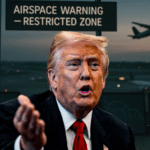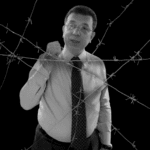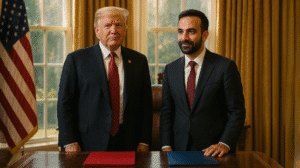On March 25, 2025, the streets of Beit Lahia in northern Gaza became the epicenter of a significant protest against Hamas, the governing authority of the Gaza Strip. Hundreds of Palestinians gathered near the Indonesian hospital, voicing their frustration with the ongoing conflict and the hardships they are enduring. Chanting slogans such as “Hamas out” and “Hamas terrorists,” demonstrators called for a desire to live a normal life.
This demonstration marks one of the most substantial public expressions of dissent against Hamas since the onset of the conflict in October 2023. In past years, anti-Hamas demonstrations—such as the 2019 “We Want to Live” protests—were swiftly suppressed and under-reported in global media. This time, however, something is different. Protesters appear emboldened by desperation and disillusionment. As political analyst Dalia Ziada summarized on X, Gaza’s people are sending three clear messages to the world: “Hamas are terrorists,” “We want peace,” and “We want to live a normal life”.
The Catalysts Behind the Unrest
The protests come amid the collapse of a two-month truce between Israel and Hamas. Renewed fighting and Israeli incursions into northern Gaza have left residents battered, displaced, and without access to clean water, food, or medical aid.
People are exhausted—not only by Israeli bombardment but by what many describe as Hamas’s reckless governance. In the words of one protester: “They’ve led us into hell and left us to burn”.
The sentiments go beyond anger—they speak to a collective feeling of betrayal. With no elections since 2006 and growing isolation from the Arab world, Hamas is facing unprecedented levels of public condemnation.
The Call from the Clans
One of the most symbolic escalations came not from the street, but from tradition: the powerful Assembly of Families and Clans of Southern Gaza issued an official call for an Intifada—a popular uprising against Hamas. In a statement released on March 25 and widely circulated online, they condemned the group for “gambling with our blood and exploiting our sacrifices for their narrow interests”.
“We will no longer remain silent while our lives and future are destroyed. Enough disregard for our dignity!” — Assembly of Southern Gaza Clans.
The weight of this declaration cannot be overstated. Gaza’s clans carry deep influence, especially in rural and southern areas. For them to speak publicly—and in such explicit terms—marks a turning point that could reshape internal Palestinian politics.
Challenges in Dismantling Hamas’s Authority
Efforts to remove Hamas from power face a series of deep-rooted and complex challenges. First and foremost is the group’s entrenched political control. Since seizing power in 2007, Hamas has built a tight grip over Gaza’s administrative, military, and civil infrastructure, effectively eliminating internal opposition and making any transition of power extraordinarily difficult. Moreover, any move to unseat Hamas risks creating a power vacuum.
With no clear and organized alternative currently prepared to govern Gaza, there’s a high risk that various rival factions could clash in a struggle for dominance, plunging the territory into even greater instability and paving the way for expanded Israeli occupation.
Adding to these internal complexities are the external influences at play. Regional actors—particularly Iran and Qatar—have long backed Hamas financially, politically, and may actively work to preserve its dominance for their own strategic interests. These outside players could obstruct or manipulate any reform efforts, undermining local initiatives for change. Thus, dismantling Hamas is not merely a matter of public opposition or protest; it requires a multi-layered strategy involving political restructuring, security realignment, and the careful navigation of regional geopolitics.
Origins and Founding
Hamas (Harakat al-Muqawamah al-Islamiyyah, or Islamic Resistance Movement) was founded in 1987 in the Gaza Strip, during the early days of the First Intifada. It originated as a Palestinian offshoot of the Muslim Brotherhood, blending Sunni Islamic ideology with Palestinian nationalism. Its initial mission was to resist Israeli occupation through armed struggle.
Political and Social Structure
While widely known for its armed resistance, Hamas has developed into a complex organisation that includes:
- Military wing: Izz ad-Din al-Qassam Brigades, responsible for armed operations against Israel.
- Political wing: Participates in elections and governance, particularly in Gaza.
- Social service networks: Runs hospitals, schools, and charities, often filling gaps in local governance.
In 2006, Hamas won a surprise majority in Palestinian Legislative Council elections. The political victory over the rival Fatah party led to violent clashes and, by 2007, Hamas had seized full control of the Gaza Strip. Since then, it has operated as the de facto government of Gaza—collecting taxes, providing services, and policing the territory.
On Governance and Military Presence
Hamas is more than a guerrilla movement—it functions as a governing authority. However, unlike traditional militaries, it does not operate from identifiable bases or isolated compounds. Instead, its leadership, operatives, and weapons caches are often embedded within civilian areas. Gaza’s extreme population density and lack of open military zones further blur the lines between combatants and civilians.
This has led to frequent accusations—particularly from Israel and its allies—that Hamas uses human shields. Hamas denies this, and many experts note that there are no formal military bases in Gaza, and fighters live and operate among the civilian population, as do government officials, police, and aid workers. In effect, Gaza’s urban environment makes military and civilian life inseparable, complicating legal and ethical assessments of proportionality in armed conflict.
International Standing and Controversy
The United States, European Union, United Kingdom, and others designate Hamas as a terrorist organization, primarily due to its use of suicide bombings, rocket attacks, and rejection of Israel’s right to exist.
However, it maintains diplomatic and financial backing from regional powers like Iran and Qatar and continues to enjoy a base of support among Palestinians, especially in Gaza.
As conflict in the region persists, Hamas remains a deeply polarizing force: hailed by some as a resistance movement, condemned by others as a terrorist organization, and challenged by many within Gaza itself—especially in recent protests calling for change after years of war, economic collapse, and political stagnation.
Potential Futures for Gaza
Several paths could emerge from this moment of unrest, each with profoundly different implications for Gaza’s future.
One possibility—though currently the least likely—is a negotiated power transition, where Hamas—recognizing its eroding legitimacy—might agree to share or hand over authority to other Palestinian factions under international mediation. Such a process could involve the formation of a technocratic interim government, possibly supported by the Palestinian Authority or civil society actors, to oversee reconstruction, hold elections, and reestablish public services. Though this would be the most stable path forward, it would require both enormous international pressure and unprecedented cooperation among Palestinian political entities.
A second, more volatile scenario involves continued civil unrest. If Hamas responds to mounting protests with violence and repression—as it has in the past—the situation could spiral into widespread internal conflict. With governance structures deteriorating, public services collapsing, and no alternative leadership emerging, Gaza could descend into anarchy or warlordism, intensifying the humanitarian disaster.
In such a power vacuum, Israel may attempt to exploit the instability to expand its de facto occupation. Already in control of Gaza’s borders, airspace, and maritime access, Israel could use internal Palestinian division as justification to prolong its military operations deep into Gaza’s interior. Some analysts have warned that without a stable local authority to negotiate with, Israel may redraw security zones, enforce buffer areas, or delay indefinitely any discussion of Palestinian self-governance. This could further entrench what critics describe as a policy of “creeping annexation” under the guise of counterterrorism or humanitarian intervention.
A third scenario would be international intervention, led by regional powers or global institutions. This would not necessarily be military but could involve diplomatic isolation of Hamas, economic leverage, and active support for local civic organizations or technocratic bodies. Such a coalition would aim to pressure Hamas into political reform or facilitate a broader transition. However, this approach demands unity from actors who are often divided—particularly as Qatar and Iran continue to back Hamas financially and diplomatically.
Each of these potential futures—cooperation, collapse, or coercion—presents enormous risks and uncertainties. But what unites them is a growing realization that the status quo is no longer tenable for Gaza’s two million residents.
Why This Time Might Be Different
As Dalia Ziada noted in her viral thread on X, previous protests were quashed with silence and fear. But today’s Gaza is different: Hamas is politically isolated, Qatari media narratives are losing credibility, and the people have lost everything—except their voices.
The chants echoing across Gaza are not just slogans—they are demands for dignity, autonomy, and a life beyond perpetual war. As one protest sign reportedly read: “Gaza is not anyone’s hostage. Gaza will rise with the will of its people”.
A Final Note
The protests sweeping through Gaza are more than a political statement — they are a desperate cry for dignity, peace, and survival. After years of suffocating blockade, decades of fragmented leadership, and a long-standing Israeli occupation that controls borders, airspace, and daily life, the people of Gaza are demanding to be seen not as pawns in a political chess game, but as human beings with rights. Their voices, long suppressed, are now echoing beyond the walls of fear.
As international powers debate the next steps, the focus must return to those who have endured the greatest suffering: Gaza’s civilians. Any resolution must prioritize their safety, restore their basic rights, and invest in rebuilding not only physical infrastructure but hope.
The world must listen—not only to the chants of protest but to the silent grief of a population that has borne the weight of too much war and too little justice.
















